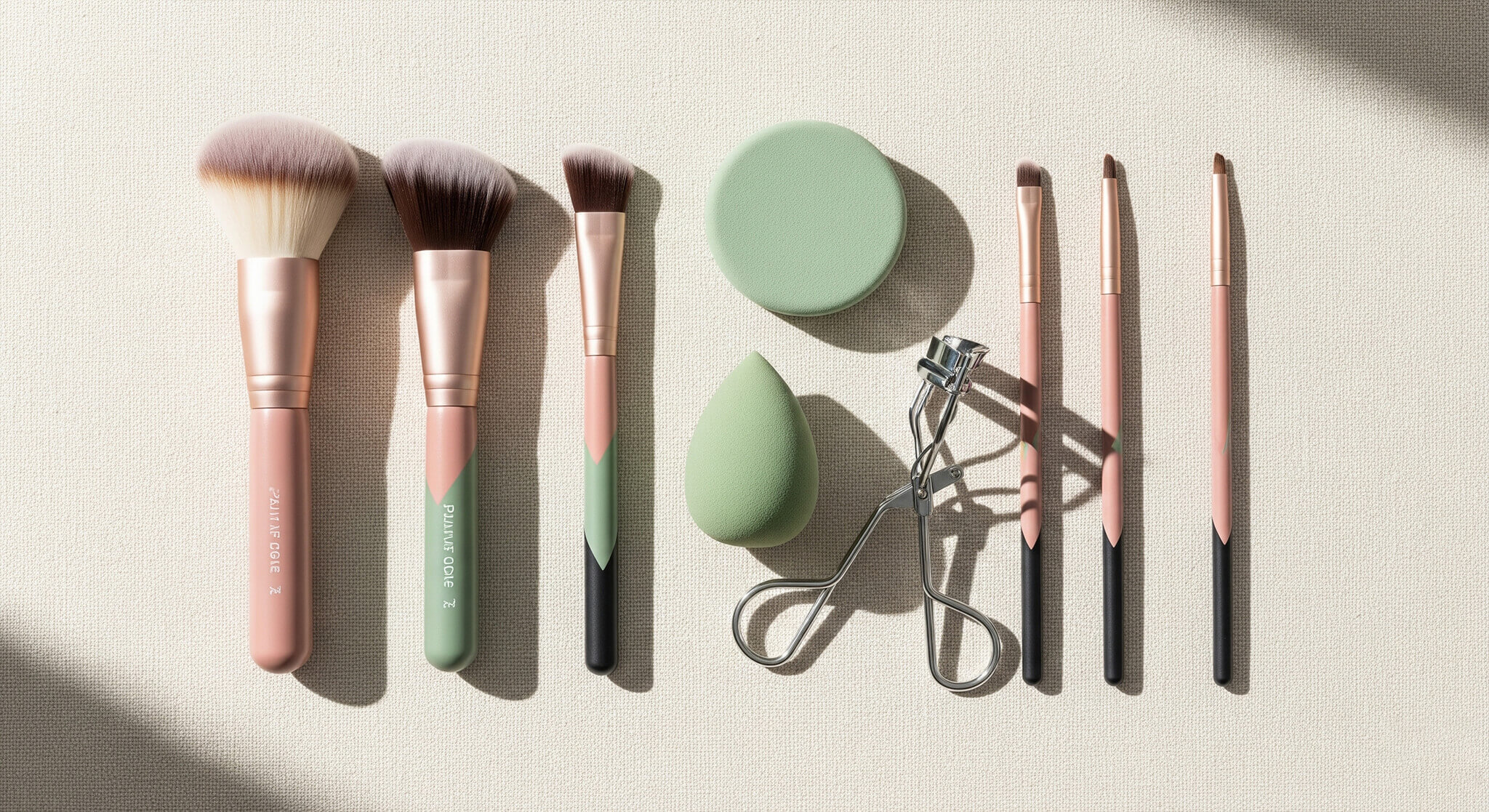A Beginner’s Guide to Makeup Brushes, Sponges & Tools
Table of contents
Beyond Your Fingertips: Why the Right Tools are a Makeup Game-Changer
You’ve invested in a great foundation and concealer, but your application still looks streaky, patchy, or just not quite right. Sound familiar? The secret to a truly flawless makeup look isn’t always the makeup itself—it’s the tools you use to apply it.
Think of it like painting. A great artist can’t create a masterpiece with their fingers alone; they need the right brushes to blend, define, and perfect their work. The same is true for makeup. The right tools can elevate your application from good to seamless, giving you a professional-looking finish every single time.
The world of makeup brushes can be overwhelming, with hundreds of shapes and sizes. But the good news is, you don’t need them all. This guide will demystify the essentials and help you build a simple, effective toolkit for a flawless application.
The Essential Toolkit: The 5 Tools Every Beginner Needs
To start, you only need a handful of versatile, high-quality tools. Master these five, and you can achieve almost any look.
1. The Foundation Tool: Brush vs. Sponge
- The Makeup Sponge: This is the modern go-to for a seamless, natural, skin-like finish. Its porous texture presses and melts liquid and cream products into the skin, avoiding streaks.
- How to Use: Always use it damp. Run it under water until it expands, then squeeze out all the excess water in a towel. Use a gentle bouncing or “stippling” motion to blend your Foundation.
- The Foundation Brush: A dense, flat-top or kabuki-style brush is excellent for achieving more coverage. It allows you to quickly buff liquid or cream Foundation into the skin for an airbrushed effect.
2. The Concealer Brush
While your finger is great for tapping in under-eye Concealer, a small, slightly pointed synthetic brush is a game-changer for covering blemishes. It allows for precise, targeted application, so you can cover the spot without applying excess product to the surrounding skin, making your cover-up look far more natural.
3. The Fluffy Powder Brush
To set your makeup without it looking heavy or cakey, you need a large, fluffy powder brush. It’s designed to pick up just the right amount of loose or pressed powder and distribute it in a light, even veil across the skin. This sets your makeup, reduces shine, and maintains a natural finish.
4. The All-Purpose Eyeshadow Brush
Don’t get lost in the sea of eye brushes. As a beginner, all you really need is one good, medium-sized, fluffy blending brush. It’s versatile enough to pack color onto your eyelid and, most importantly, to blend out the edges in your crease for that soft, diffused, professional look.
5. The Angled Brow or Liner Brush
This small, stiff, angled brush is a multitasking hero. Its sharp, precise edge is perfect for applying brow powder or pomade with realistic, hair-like strokes. It can also be turned on its side and used to apply gel eyeliner or to press dark eyeshadow along your lash line for soft definition.
Understanding Brush Types: Natural vs. Synthetic
The bristles of a brush determine what products it works best with.
Natural Bristles
Made from various types of animal hair, these bristles are porous and have a cuticle, just like human hair. This texture makes them excellent for picking up and blending powder products like blush, bronzer, and powder eyeshadow.
Synthetic Bristles
Made from man-made fibers like nylon or taklon, these bristles are non-porous and smooth. They don’t absorb as much product, which makes them the perfect choice for liquid and cream products like Foundation, Concealer, and cream blush. They ensure a smooth application without wasting your makeup.
How to Clean Your Tools (A Non-Negotiable Step)
Dirty tools are a breeding ground for bacteria, which can cause breakouts, clogged pores, and skin irritation. They also perform poorly, leading to a streaky, patchy application. Cleaning your tools is non-negotiable for both your skin health and a flawless finish.
Weekly Deep Clean
Once a week, give your tools a proper bath.
- Wet the bristles (or sponge) with lukewarm water, pointing the brush downwards to avoid getting water in the handle.
- Place a drop of gentle soap (baby shampoo works great) or a specific brush cleanser into the palm of your hand.
- Gently swirl the brush or sponge in your palm until it lathers up and the makeup residue is gone.
- Rinse thoroughly under lukewarm water until the water runs completely clear.
- Gently squeeze out excess water, reshape the bristles with your fingers, and lay your brushes flat on a clean towel to dry. Let sponges air dry completely.
Daily Spot Clean
For daily maintenance, especially for eyeshadow brushes when switching colors, use a brush cleaning spray. Spritz it onto a paper towel and swirl your brush on the towel until the pigment is gone.
Makeup Tool FAQ
If I can only buy one tool, what should it be?
A high-quality Makeup Sponge. It’s incredibly versatile. You can use it to apply Foundation, blend Concealer, apply cream blush, and even press on setting powder. It is the ultimate multitasking tool for a beginner.
How often do I really need to replace my makeup sponge?
For hygiene reasons and best performance, it’s recommended to replace your makeup sponge every 3 months, even with regular and thorough cleaning. Over time, they can harbor bacteria and start to break down.
Do I need a different brush for every single eyeshadow color?
No, definitely not as a beginner. You can use your one all-purpose blending brush for a whole look. Simply wipe it clean on a dry paper towel or a color-switching sponge between applying different shades.
What is the one makeup tool you can’t live without? Share your must-have in the comments below!
